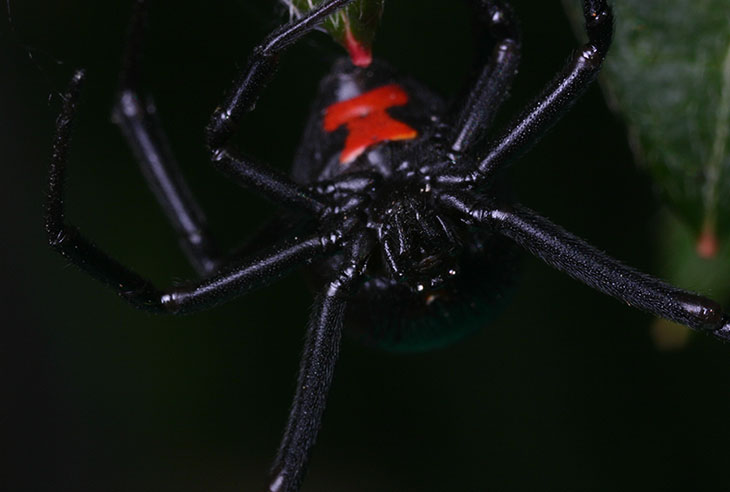Yes, I have to do this:

This is actually the first specimen I’ve found this year, which was a slight frustration since there was a particular image that I wanted and couldn’t find a model. Just in case it wasn’t immediately apparent, this is a southern black widow, Latrodectus mactans, distinguished from the northern variant (we have both here) by the lack of markings on the upper abdomen, and the joined halves of the hourglass. Kindly note the reflections from two of the eyes.

 The image above is the belly of course, not quite the classic hourglass but close enough to get the job done. The markings work better than you might imagine, since widows usually sit belly-up in the web so the marking is obvious. My main subject is a female, able to be told by the size, shape, markings and, if all that wasn’t enough, the pedipalps. The males, seen in an archive image at left, are radically different, and I suspect remain unidentified in most encounters. They’re significantly smaller, and their chelicerae are inadequate to penetrate skin in most cases, so the threat is virtually nonexistent. The threat from the adult females is pretty low too, since they purposefully avoid contact and areas of human activity. To get bitten, you pretty much have to pin one down without going so far as to kill it, which is a rather narrow range of conditions for an accidental encounter. Much as I crawl around in prime environments and actually handle spiders, I might not ever have been bitten – the one illness that I originally attributed to a black widow bite is now highly questionable. This is true of many suspected bites, since a large variety of things can produce the same wide range of symptoms that spider bites are reputed to have – there are no key symptoms that point directly to spiders, and entomologists maintain that if you didn’t actually see the culprit, the chances are low that whatever reaction you’re having came from a spider.
The image above is the belly of course, not quite the classic hourglass but close enough to get the job done. The markings work better than you might imagine, since widows usually sit belly-up in the web so the marking is obvious. My main subject is a female, able to be told by the size, shape, markings and, if all that wasn’t enough, the pedipalps. The males, seen in an archive image at left, are radically different, and I suspect remain unidentified in most encounters. They’re significantly smaller, and their chelicerae are inadequate to penetrate skin in most cases, so the threat is virtually nonexistent. The threat from the adult females is pretty low too, since they purposefully avoid contact and areas of human activity. To get bitten, you pretty much have to pin one down without going so far as to kill it, which is a rather narrow range of conditions for an accidental encounter. Much as I crawl around in prime environments and actually handle spiders, I might not ever have been bitten – the one illness that I originally attributed to a black widow bite is now highly questionable. This is true of many suspected bites, since a large variety of things can produce the same wide range of symptoms that spider bites are reputed to have – there are no key symptoms that point directly to spiders, and entomologists maintain that if you didn’t actually see the culprit, the chances are low that whatever reaction you’re having came from a spider.

I like this shot for the ominous quality (well, even more ominous, okay?) – yes, the eyes are making an appearance again. Black widows are not the easiest subjects to work with – aside from the obvious reasons not to provoke a bite, they’re very shy and prefer to find shelter, and can be hard to convince to hold still, especially so if there’s a particular angle that you’re after. I can also vouch for the fact that when they dangle on a webline from the branch you’re using, it looks just as evil as is often depicted in movies and cartoons – lowering slowly with apparent menace, legs spread and gently stroking the air seeking purchase. I was unable to capture this because it was so brief and I couldn’t switch zoom settings fast enough. I had been smart, knowing this was going to happen, and suspended the branch and clamp rig in a shallow pan of water, which she encountered while trying to escape, sending her back up to the branch; widows cannot scamper across the water like many arachnids can.
But the shot I was really after was this:

There’s a face only a mother could love. I was hoping to get a peek at the chelicerae, seeing as how they’re the business end of an infamous species, but not one angle I tried gave me a decent view. If you go back to the image at top, recognize that the abdomen is about the size of a large pea, so the cephalothorax is pretty small overall, and the chelicerae are thus described by the biological term, “eentsy.”
Since you’ve been examining these pics closely, you might be thinking that she’s missing a leg, but that’s only the way the legs are positioned in the top pic. True enough, a high number of arachnids that I find are missing a leg or two. Life can be tough for spiders, which is enough to make you have some sympathy for them, isn’t it?
No, huh?




















































